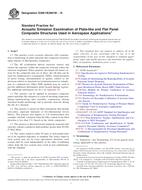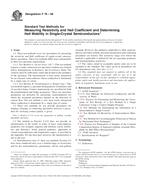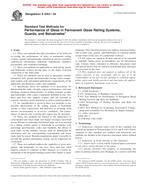1.1 This guide provides field data collection and calculation methodologies for the estimation of light non-aqueous phase liquid (LNAPL) transmissivity in unconsolidated porous sediments. The methodologies presented herein may, or may not be, applicable to other hydrogeologic regimes (for example, karst, fracture flow). LNAPL transmissivity represents the volume of LNAPL (L³) through a unit width (L) of aquifer per unit time (t) per unit drawdown (L) with units of (L²/T). LNAPL transmissivity is a directly proportional metric for LNAPL recoverability whereas other metrics such as apparent LNAPL thickness gauged in wells do not exhibit a consistent relationship to recoverability. The recoverability for a given gauged LNAPL thickness in a well will vary between different soil types, LNAPL types or hydrogeologic conditions. LNAPL transmissivity accounts for those parameters and conditions. LNAPL transmissivity values can be used in the following five ways: (1) Estimate LNAPL recovery rate for multiple technologies; (2) Identify trends in recoverability via mapping; (3) Applied as a leading (startup) indicator for recovery; (4) Applied as a lagging (shutdown) indicator for LNAPL recovery; and (5) Applied as a robust calibration metric for multi-phase models (Hawthorne and Kirkman, 2011 (1) and ITRC ((2)). The methodologies for LNAPL transmissivity estimation provided in this document include short-term aquifer testing methods (LNAPL baildown/slug testing and manual LNAPL skimming testing), and long-term methods (that is, LNAPL recovery system performance analysis, and LNAPL tracer testing). The magnitude of transmissivity of any fluid in the subsurface is controlled by the same variables (that is, fluid pore space saturation, soil permeability, fluid density, fluid viscosity, the interval that LNAPL flows over in the formation and the gravitational acceleration constant). A direct mathematical relationship exists between the transmissivity of a fluid and the discharge of that fluid for a given induced drawdown. The methodologies are generally aimed at measuring the relationship of discharge versus drawdown for the occurrence of LNAPL in a well, which can be used to estimate the transmissivity of LNAPL in the formation. The focus, therefore, is to provide standard methodology on how to obtain accurate measurements of these two parameters (that is, discharge and drawdown) for multi-phase occurrences to estimate LNAPL transmissivity.
1.2 Organization of this Guide:
1.2.1 Section 2 presents documents referenced.
1.2.2 Section 3 presents terminology used.
1.2.3 Section 4 presents significance and use.
1.2.4 Section 5 presents general information on four methods for data collection related to LNAPL transmissivity calculation. This section compares and contrasts the methods in a way that will allow a user of this guide to assess which method most closely aligns with the site conditions and available data collection opportunities.
1.2.5 Sections 6 and 7 presents the test methods for each of the four data collection options. After reviewing Section 5 and selecting a test method, a user of this guide shall then proceed to the applicable portion of Sections 6 and 7 which describes the detailed test methodology for the selected method.
1.2.6 Section 8 presents data evaluation methods. After reviewing Section 5 and the pertinent test method section(s) of Sections 6 and 7, the user of this guide shall then proceed to the applicable portion(s) of Section 8 to understand the methodologies for evaluation of the data which will be collected. It is highly recommended that the test methods and data evaluation procedures be understood prior to initiating data collection.
1.3 The values stated in inch-pound units are to be regarded as standard. The values given in parentheses are mathematical conversions to SI units that are provided for information only and are not considered standard.
1.4 This standard does not purport to address all of the safety concerns, if any, associated with its use. It is the responsibility of the user of this standard to establish appropriate safety and health practices and determine the applicability of regulatory limitations prior to use.
1.5 This document is applicable to wells exhibiting LNAPL consistently (that is, LNAPL transmissivity values above zero). This methodology does not substantiate zero LNAPL transmissivity; rather the lack of detection of LNAPL within the well combined with proper well development and purging procedures are required to confirm zero LNAPL transmissivity.
1.6 This document cannot replace education or experience and should be used in conjunction with professional competence in the hydrogeology field and expertise in the behavior of LNAPL in the subsurface.
1.7 This document cannot be assumed to be a substitute for or replace any laws or regulations whether federal, state, tribal or local.
Product Details
- Published:
- 11/01/2011
- Number of Pages:
- 66
- File Size:
- 1 file , 5.6 MB


